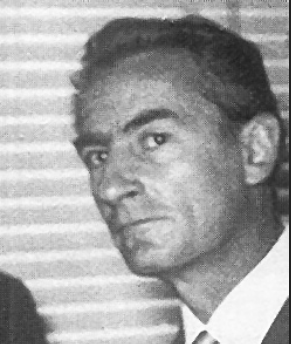Gilberto Bernardini
(physicist) | |
|---|---|
 | |
| Born | 28 August 1906 Fiesole, Italy |
| Died | 4 August 1995 (Age 88) Fiesole, Italy |
| Nationality | Italian |
| Alma mater | Pisa University |
Gilberto Bernardini was an Italian physicist and academic.[1] He attended the 1970 Bilderberg meeting.
Early life
He graduated with honors in physics at the University of Pisa in the academic year 1927-28 with Luigi Puccianti[2][3], as a student also of the Scuola Normale Superiore of Pisa starting from 1923, soon after he found a first job at an optical-mechanical construction company in Florence also associated with the National Institute of Optics in Florence, where he remained until 1930, while teaching at the local scientific high school.
In 1930, he took on the role of assistant of rational mechanics at the University of Florence , then, in 1931, that of experimental physics , collaborating with Giuseppe Occhialini , in the research group directed by Bruno Rossi, in the development of new techniques and tools for the search for atomic particles.
In the years from 1934 to 1937, with a scholarship from the Accademia Nazionale dei Lincei , he moved to Germany , where he studied at the Kaiser Wilhelm Society in Berlin , with Otto Hahn and Lise Meitner.
Career
Back in Italy, he was appointed professor at the University of Camerino in 1937, after which he moved to Bologna, teaching experimental physics there from 1938 to 1946. There he became full professor of experimental physics in 1941, and was director of the Institute of Physics until 1946. In those years, he founded an Italian school on cosmic rays, promoting the construction and directing the research program of the Testa Grigia laboratories, at 3500 meters above sea level, in Cervinia.
After the war, he moved to the University of Rome, where he first held the chair of spectroscopy and then that of experimental physics. Here, with great vitality and spirit of initiative, together with Edoardo Amaldi, he promoted the resumption of physics research in Italy. In 1964 he moved to Pisa, teaching at the university and the Scuola Normale Superiore, until his retirement in 1977.
He was the leader of the Italian group of research on cosmic rays. In this field, his works on electromagnetic showers, muon decay, the theory of multiplicative processes, as well as the study of the photoreproduction of pions stand out. He also made notable contributions to nuclear physics and elementary particle physics.[4]
In 1949, he went, by invitation, to the United States, as a visiting professor first at Columbia University and then, from 1951 to 1956, in Urbana (Illinois) and Chicago, where, as a research full professor, he carried out important studies on pions. In 1951, having returned to Italy but still maintaining contacts with the United States, he helped found the National Institute of Nuclear Physics, becoming its first president until 1959.
During this period, he promoted the start-up, in Italy, of a new research program in the field of subnuclear physics, starting the construction (from 1953 to 1958) of the Frascati laboratories, creating, together with Giorgio Salvini, the first electrosynchrotron from 1100 Mev, which was then, for a time, the most powerful in the world. Around them, a valid and prepared Italian group of physicists and researchers, from Pisa and Rome, was formed, among the best in the world, bringing the Italian school of Physics to the highest international levels.
From 1957 to 1964, he was also Director of Research of CERN in Geneva and of the research group of the protosyncroton, in the years 1957 - 60. In these years, he directed, among other things, the research group of which Antonino Zichichi was also a part, personally involved, together with other valid foreign physicists, in important research projects in high energy physics; among these, the crucial one that will lead to the discovery of antimatter[5] .
He was then president of the Italian Physical Society (SIF) from 1962 to 1966 and, in 1968, he was one of the founders and first president of the European Physical Society (EPS), until 1970. He was a member of the Accademia Nazionale dei Lincei since 1949, the Academies of Sciences of Bari, Modena and Bologna, the Accademia dei XL since 1970, the American Physical Society (AIP) and the Institute of Physics (IOP) in London. He was also vice-president of the Institute of the Italian Encyclopedia.
He obtained many prizes, awards and honors, including the gold medal of the Italian Physical Society (SIF), which then established an annual award for young researchers dedicated to him, the Augusto Righi medal in 1955, the Tate Medal of the European Physical Society (EPS) in 1971, the gold medal of Meritorious School, Culture and Art in 1965, the honorary degree from the University of Rochester and, in 1974, the French honor of the Legion d'Honneur, the title he loved most.
Event Participated in
| Event | Start | End | Location(s) | Description |
|---|---|---|---|---|
| Bilderberg/1970 | 17 April 1970 | 19 April 1970 | Switzerland Hotel Quellenhof Bad Ragaz | the 19th Bilderberg meeting, in Switzerland. |
References
Wikipedia is not affiliated with Wikispooks. Original page source here